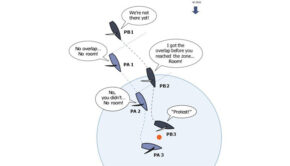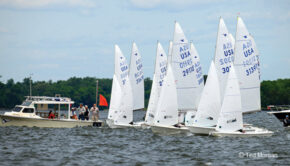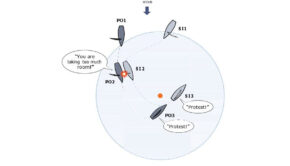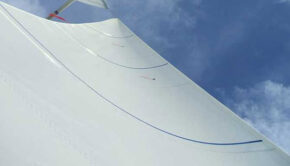EDUCATION: Open Class(room)
Published on June 20th, 2013
By Joe Cooper, WindCheck
The scene: A lovely Sunday afternoon on our favorite body of water…steering our boat upwind. The sails are trimmed just so, the boat is at about 12-15 degrees of heel, feels great and you know it is going “fast” without looking at the TV on the binnacle. Quick question: How many disciplines of science and math are being employed in this scene? Answer: Lots.
Hydrodynamics, including displacement volume, lift from a keel (more correctly reported as reduced leeway), wave length, drag (both shape-induced and laminar drag; the latter from rolled-on bottom paint, not wet-sanded, aerodynamics including lift and drag from the sails, and parasitic drag from the standing rigging, the halyard stowed on the front of the mast, the spreaders, lifelines, the surface of the hull exposed to the wind, the cabin top, dodger and bimini.
The whole sailing operation is one huge force vector. Yeah, OK. So?…Pass the sunscreen…
The disciplines used in “just” sailing use many of the subjects that kids, especially high school kids, wrestle with at school. If you concede that we all learn more effectively and more thoroughly when engaged in the lesson, then making the learning experience more engaging for kids must help them understand and retain the meat of the lessons they will need over their lifetime.
My high school life was lived within sight of Sydney Harbor or the Tasman Sea, depending on which room I was in. I was, as measured by the quantifiable standards of the day, a pretty dull student, barely scraping by. The paragraphs above are all things I have learned since leaving school in 1970. For years I have maintained that sailing is a great activity with which to demonstrate, and give practical application to, the subjects that high school kids have to study and really know about.
I have learned about geography, oceanography, meteorology, economics, history and people through sailing. Not to mention engineering, strengths of materials, navigation, and perhaps a dozen more skills that are useful in all walks of life.
From 1993 – ‘96 I ran a non-profit called Sailing As Integrated Learning (SAIL). The idea was to use interesting sailing adventures to expose kids to all the disciplines in a way that was fun, interesting and compatible with their lessons. My idea was an expansion of what the BOC Race (now the Velux Five Oceans) was doing.
One of the projects I did was taking a Quest 30 from Newport, RI to Plymouth, England for the owner to race back in the O.S.T.A.R (Observer Singlehanded Transatlantic Race). Using very rudimentary (by today’s standards) satellite comms, I was able to communicate with about half a dozen middle schools.
I was later told that when I went off the air for a couple of days due to engine (thus electric) problems, the kids would come to school at 0700 rather than the required 0800 in order to track things like the ice reports from the Canadian Coast Guard. Their teacher also told me he had never seen his kids so excited at being in school while learning about latitude and longitude, ocean currents, ice formation, flow and melt, and weather. – Read on








 We’ll keep your information safe.
We’ll keep your information safe.